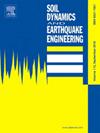A computational framework for site-city interaction analysis considering seismic wave propagation effects and its application to Beijing CBD
IF 4.2
2区 工程技术
Q1 ENGINEERING, GEOLOGICAL
引用次数: 0
Abstract
Earthquake waves are generated by fault rupture, propagate through rocks and soil layers to local sites, and then excite buildings on the site. The densely distributed buildings will interact with the site and each other (site-city interaction effects, SCI effects), altering the dynamic responses of the site and the propagation process of earthquake waves. Therefore, the actual seismic motions experienced by urban building clusters are the result of the combined effects of SCI effects and earthquake wave propagation effects (such as rupture directivity effects, traveling wave effects, topographic effects, etc.). This paper proposes a computational framework for site-city interaction analysis considering seismic wave propagation effects based on the domain reduction method and nonlinear numerical coupling scheme. Taking the 2021 buildings in the Beijing central business district (CBD) as an example, the paper analyzes the influence of different building clusters on the responses of the site and building clusters under the Sanhe-Pinggu earthquake. The research results indicate that building clusters significantly affect both the site and the responses of surrounding buildings, with an influence extending over 200 m, warranting close attention.
考虑地震波传播效应的地城相互作用分析计算框架及其在北京CBD的应用
地震波是由断层破裂产生的,通过岩层和土层传播到局部场地,然后激发场地上的建筑物。密集分布的建筑将与场地和彼此相互作用(场地-城市相互作用效应,SCI效应),改变场地的动力响应和地震波的传播过程。因此,城市建筑群实际经历的地震运动是SCI效应和地震波传播效应(如破裂指向性效应、行波效应、地形效应等)共同作用的结果。本文提出了一种考虑地震波传播效应的场地-城市相互作用分析的计算框架,该框架基于域约简法和非线性数值耦合格式。本文以北京中央商务区2021栋建筑为例,分析了不同建筑群对三河-平谷地震作用下场地和建筑群反应的影响。研究结果表明,建筑集群对场地和周围建筑的响应都有显著影响,影响范围超过200 m,值得密切关注。
本文章由计算机程序翻译,如有差异,请以英文原文为准。
求助全文
约1分钟内获得全文
求助全文
来源期刊

Soil Dynamics and Earthquake Engineering
工程技术-地球科学综合
CiteScore
7.50
自引率
15.00%
发文量
446
审稿时长
8 months
期刊介绍:
The journal aims to encourage and enhance the role of mechanics and other disciplines as they relate to earthquake engineering by providing opportunities for the publication of the work of applied mathematicians, engineers and other applied scientists involved in solving problems closely related to the field of earthquake engineering and geotechnical earthquake engineering.
Emphasis is placed on new concepts and techniques, but case histories will also be published if they enhance the presentation and understanding of new technical concepts.
 求助内容:
求助内容: 应助结果提醒方式:
应助结果提醒方式:


